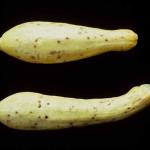Cucurbits, Scab
Cladosporium cucumerinum
Scab, caused by Cladosporium cucumerinum is a significant problem for summer and winter squash, pumpkin, melon, and watermelon. Resistant cultivars of cucumber are widely available. The fungus can infect all above ground portions of the plant, but is most serious when it occurs on fruit.
Identification:
On foliage, the first sign of the disease is pale-green, water-soaked lesions which turn gray and become angular. These lesions may appear with a yellow halo that can become shot-holed in appearance. Numerous lesions may cause leaf twisting and deformation. On fruit, spots first appear as small sunken areas which can be mistaken for insect injury. The spots may ooze a sticky liquid and become crater-like as they darken with age. Dark green, velvety layers of spores may appear in the cavities and secondary soft-rotting bacteria can invade. Severity of symptoms varies with the age of fruit when it becomes infected.
Life Cycle:
The pathogen survives in the soil on infected crop debris for up to three years, may be seedborne, and is capable of saprophytic growth. The disease is favored by fog, heavy dew, light rains, and cool temperatures. The pathogen spreads on moist air, on insects, equipment, and humans. C. cucumerinum overwinters in infected squash and pumpkin 4 vines, soil, and may also be seed-borne. Spores produced in the spring can infect in as little as 9 hours, produce spots by 3 days, and produce a new crop of spores by 4 days.
Cultural Controls & Prevention:
- Rotate with non-cucurbit crops for 2-3 years.
- Plant resistant cultivars if available.
- Use seed that does not have significant levels of the pathogen.
- Select sites with well-drained soil and good air movement for rapid drying of foliage and fruit.
- Avoid overhead irrigation and dense plant canopies.
- Protectant fungicides are recommended for control. Fungicide sprays may not be effective during extended cool, wet weather due to the short disease cycle of this pathogen.
- To be effective, fungicides must be applied before fruit formation.
Chemical Controls & Pesticides:
For current information on disease recommendations in specific crops including information on chemical control & pesticide management, please visit the New England Vegetable Management Guide website.
Crops that are affected by this disease:
The Center for Agriculture, Food and the Environment and UMass Extension are equal opportunity providers and employers, United States Department of Agriculture cooperating. Contact your local Extension office for information on disability accommodations. Contact the State Center Director’s Office if you have concerns related to discrimination, 413-545-4800 or see ag.umass.edu/civil-rights-information.
